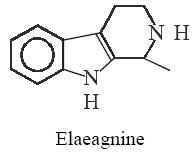D. Elaeagnine
Biological Source It is obtained from the bark of Elaeagnus angustifolia Linn., (Synonyms: E. hortensis Bieb.) (Elaeagnaceae).
Chemical Structure
Biosynthesis of Elaeagnine, Harman, Harmaline and Harmine The various steps involved in the biosynthesis of the above mentioned four alkaloids are briefly summarized as under:
1. Tryptamine and acetyl carboxylic acid (i.e., keto acid) undergoes a Mannich-like reaction to yield a β-carboline carboxylic acid, which on oxidative decarboxylation gives rise to 1-methyl β-carboline.
2. The resulting product on subsequent reduction gives rise to the alkaloid elaeagnine.
3. The 1-methyl β-carboline upon mild oxidation yields the alkaloids harman with the elimination of a mole of water from the 6-membered heterocyclic nucleus.
4. The 1-methyl β-carboline upon hydroxylation followed by methylation produces harmaline.
5. Harmaline on further oxidation generates harmine by the loss of a mole of water from the 6-membered pyridine ring at C-3 and C-4 positions.
The these steps are sequentially arranged in the following course of reactions:




0 Comment:
Post a Comment